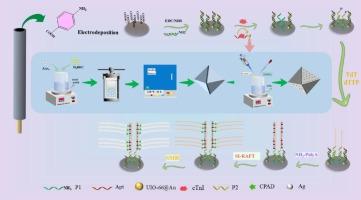基于金属-有机骨架和纳米银作为响应信号的比例电化学传感器用于cTnI检测
IF 4.5
2区 化学
Q1 BIOCHEMISTRY & MOLECULAR BIOLOGY
引用次数: 0
摘要
心肌肌钙蛋白I (cTnI)的浓度是心肌损伤的一个公认的生物标志物。在这项工作中,利用锆金属有机框架(UiO-66)和AgNPs作为电化学信号标签,开发了一种比例电化学感应传感器,用于超灵敏检测心脏肌钙蛋白I (cTnI)。在cTnI与适体特异性结合后,探针1 (P1)与适体分离,导致UiO-66信号减弱。同时,末端脱氧核苷酸转移酶(TdT)介导的信号扩增为表面引发的可逆加成断裂链转移(SI-RAFT)聚合提供了大量活性位点,导致大量银纳米粒子沉积在电极表面,银离子信号增强。测定cTnI的浓度范围为1 × 10−3-1 × 102 ng mL−1,检出限低至20.53 fg mL−1。值得注意的是,比例传感器在检测患者血清样本中的cTnI方面表现良好,显示了临床应用潜力。重要的是,该适体传感器在检测人血清样品中的cTnI方面表现出优异的性能,突出了其强大的临床应用潜力。本文章由计算机程序翻译,如有差异,请以英文原文为准。

Ratiometric electrochemical sensor based on metal-organic framework and nanosilver as response signals for cTnI detection
The concentration of cardiac troponin I (cTnI) serves as a well-established biomarker of myocardial injury. In this work, a ratiometric electrochemical aptasensor utilizing Zirconium-metal organic framework (UiO-66) and AgNPs as electrochemical signaling tags were developed for the ultrasensitive detection of cardiac troponin I (cTnI). Upon specific binding between cTnI and the aptamer, probe 1 (P1) dissociated from the aptamer, resulting in a decreased UiO-66 signal. Meanwhile, signal amplification mediated by terminal deoxynucleotide transferase (TdT) provided a substantial quantity of active sites for surface-initiated reversible addition fragmentation chain transfer (SI-RAFT) polymerization, leading to a massive amount of silver nano-particles deposited on the electrode surfaces with enhanced silver ion signals. The concentration range of cTnI was determined to be 1 × 10−3–1 × 102 ng mL−1, with a detection limit as low as 20.53 fg mL−1. Notably, the ratiometric sensor performed well in detecting cTnI in serum samples from patients, indicating clinical application potential. Importantly, the aptasensor exhibited excellent performance in detecting cTnI in human serum samples, highlighting its strong potential for clinical application.
求助全文
通过发布文献求助,成功后即可免费获取论文全文。
去求助
来源期刊

Bioelectrochemistry
生物-电化学
CiteScore
9.10
自引率
6.00%
发文量
238
审稿时长
38 days
期刊介绍:
An International Journal Devoted to Electrochemical Aspects of Biology and Biological Aspects of Electrochemistry
Bioelectrochemistry is an international journal devoted to electrochemical principles in biology and biological aspects of electrochemistry. It publishes experimental and theoretical papers dealing with the electrochemical aspects of:
• Electrified interfaces (electric double layers, adsorption, electron transfer, protein electrochemistry, basic principles of biosensors, biosensor interfaces and bio-nanosensor design and construction.
• Electric and magnetic field effects (field-dependent processes, field interactions with molecules, intramolecular field effects, sensory systems for electric and magnetic fields, molecular and cellular mechanisms)
• Bioenergetics and signal transduction (energy conversion, photosynthetic and visual membranes)
• Biomembranes and model membranes (thermodynamics and mechanics, membrane transport, electroporation, fusion and insertion)
• Electrochemical applications in medicine and biotechnology (drug delivery and gene transfer to cells and tissues, iontophoresis, skin electroporation, injury and repair).
• Organization and use of arrays in-vitro and in-vivo, including as part of feedback control.
• Electrochemical interrogation of biofilms as generated by microorganisms and tissue reaction associated with medical implants.
 求助内容:
求助内容: 应助结果提醒方式:
应助结果提醒方式:


